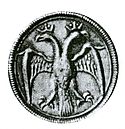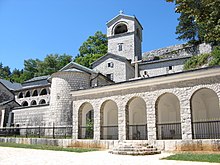Ivan Crnojević
| Ivan Crnojević | |
|---|---|
Old Cetinje Monastery (today Court Church in Ćipur) | |
| Spouses | Goisava Arianiti-Comneniates Mara Vukčić Kosača |
| Issue | |
Mara Kastrioti | |
| Religion | Serbian Orthodox Christianity |
| Seal |  |
Ivan Crnojević (
Early life
Ivan Crnojević was a member of the
Reign
Lord of Zeta
In the beginning of his reign Ivan was at very bad relations with the Republic of Venice, whom he saw as occupiers of his cities.[10] In return, the Venetians put a price on his head in 1465. But thanks to moves of the Stefan Vukčić and Skanderbeg,[11] in 1466 he became a duke under payment from the Venetian Republic with the capital in Žabljak at Lake Skadar. His payment was quite fair, 1,200 ducats annually. In 1469 Ivan remarried, to Mara, the daughter of Stefan Vukčić.

Ivan Crnojević fought for the Venetians in their wars against the
After this success, Ivan planned to liberate
Ottomans then concentrated their forces at Venetian held
Venice ended sixteen-year war with Ottomans by signing the peace treaty with Ottomans. That way Venice sacrificed its ally Ivan Crnojević who was not included into the peace treaty and had to leave his Zeta and find a haven in Italy.[21]
Return to Zeta

After Sultan
The new Ottoman sultan Bayezid accepted Ivan as his vassal. In order to guarantee his loyalty to the Sultan, Ivan sent his youngest son
The center of his renewed realm was at Obod above the
Legacy

Ivan brought a range of legislative acts that were later of great importance for the legal and cultural history of a future
Ivan's last capital Cetinje, a town founded by him, became the capital of Prince-Bishopric of Montenegro at the end of the 17th century. The modern-day Cetinje Monastery was built between 1701 and 1704 on the site of the former Ivan's court.[24] On the site of the monastery of the Mother of Christ built by Ivan, prince Nicholas built a new church in the 19th century, so called Court Church. In the 20th century the church went through several major reconstructions. During one of them Ivan's grave was found and his bones were moved to the bank safe. In 2010 Montenegrin government buried the bones of Ivan Crnojević in the Court Church, in a ceremony which was closed for the public.[need quotation to verify]
Notes
- Serbo-Croatian, his name is spelled Ivan Crnojević (Serbo-Croatian Cyrillic: Иван Црноjeвић), which is also the spelling mostly used in English sources. He is also known as Ivanbeg Crnojević (Иванбег Црнојевић) and Ivan the Black[25] (Ivan Crni / Иван Црни). His given name may also be rendered Jovan (Јован). In Italian, his name is rendered Giovanni Cernovichio.
References
- ^ a b "Ivan the Black | Serbian leader | Britannica". Archived from the original on 2020-10-28. Retrieved 2020-10-25.
- ^ a b Veselinović & Ljušić 2008, p. 34.
- ^ Erdeljan 2021, p. 46: "Cathalina′s father was Andrija Crnojević, brother of Serbian ruler of Zeta, Ivan Crnojević..."
- ^ Kovijanić 1963, p. 128.
- ISBN 0-520-03608-5.
- ^ Sima M. Ćirković (1964). Herceg Stefan Vukčić-Kosača i njegovo doba. Naučno delo. p. 189. Archived from the original on 13 March 2023. Retrieved 24 April 2013.
Иван Црнојевић је био на херцеговом двору непрекидно од 1444. или још годину две раније.
- ^ Milivoje Pajović (2001). Vladari srpskih zemalja. Gramatik. p. 132. Retrieved 24 April 2013.
Његов син Иван био је извесно време талац код војводе Стефана Вукчића Косаче, што је Стефаницу спречавало у самосталном деловању у Зети и приближавању Венецији
- ^ Sima M. Ćirković (1964). Herceg Stefan Vukčić-Kosača i njegovo doba. Naučno delo. p. 189. Archived from the original on 13 March 2023. Retrieved 24 April 2013.
- ^ Dragoslav Srejović; Slavko Gavrilović; Sima M. Ćirković (1982). Istorija srpskog naroda: knj. Od najstarijih vremena do Maričke bitke (1371). Serbian Literary Guild. p. 405. Retrieved 24 April 2013.
- ^ Stanoje Stanojević; Dragoslav Stranjaković; Petar Popović (1934). Cetinjska škola: 1834-1934. Štamparija Drag. Gregorića. p. 8. Retrieved 24 April 2013.
Стеванов наследник Иван (1455 — 1490) у почетку своје владе напустио је очеву политику добрих односа са Млечићима.
- ^ Dragoslav Srejović; Slavko Gavrilović; Sima M. Ćirković (1982). Istorija srpskog naroda: knj. Od najstarijih vremena do Maričke bitke (1371). Srpska književna zadruga. p. 405. Retrieved 22 April 2013.
То је предлагао и Скендербег, па је Република прихватила Ивана
- from the original on 2023-03-13, retrieved 2020-12-12,
У одбрани Скадра важну улогу играо је Иван Црнојевић обезбијеђујући везу с Котором и дотурање помоћи преко Жабљака и Скадарског језера. Морао је да одбија нападе великих турских одреда.
- ^ Srejović 1981, p. 406
Преко Котора је брдским путевима пребацивао људе и грађу од које би се, кад стигне у Жабљак, изградиле фусте и изненадили Турци на Скадарском језеру.
- ^ Srejović 1981, p. 407
Иван Црнојевић је господарио Скадарским језером уз помоћ три фусте и 15 мањих бродова. То је било веома значајно, јер велика млетачка флота није могла да се пробија дал.е од Светог Срђа
- ^ Lazo M. Kostić (1960). O zastavama kod Srba: istoriska razmatranja. Izd. piscevo. p. 17. Archived from the original on 13 March 2023. Retrieved 24 April 2013.
а Иван Црнојевић је, због помоћи коју је указао Млечићима приликом турске опсаде Скадра, дсбио 1474 разне дарове од Млетачког сената, па и једну ратну за- ставу.
- ISBN 978-0-472-08260-5, archivedfrom the original on 2023-03-13, retrieved 2020-12-12,
The second Ottoman wave of 1477 overran much of Zeta, taking Žabljak and the late in 1477 or early 1478 meeting and defeating John Crnojevićs main army.
- ^ Radovan Samardžić (1892). Istorija srpskog naroda: Doba borbi za očuvanje i obnovu države 1371-1537. Srpska knjiiževna zadruga. p. 419. Archived from the original on 13 March 2023. Retrieved 24 April 2013.
После повлачења из Жабљака, Иван Црнојевић је боравио у Ободу (Ријека Црнојевића), који је утврдио око 1475. године.
- ^ a b Евгениј Љвович Немировски (1996). Почеци штампарства у Црној Гори, 1492-1496. ЦНБ "Ђурђе Црнојевић". p. 99. Archived from the original on 13 March 2023. Retrieved 24 April 2013.
Како је Жабљак био разрушен, Иван Црнојевић је пренио престоницу на Обод или Ријеку, утврђено мјесто код извора ријеке, која је касније добила назив Ријека Црнојевића.
- ISBN 978-0-472-08260-5, archivedfrom the original on 2023-03-13, retrieved 2020-12-12,
The Ottomans then concentrated their forces at Skadar..
- ^ Srejović 1981, p. 410
Уз помоћ Дубровчана људи Ивана Црнојевића су крстарили језером и ноћу нападали турске шаторе. Иванов син је у свом завештању из 1499. године навео како је његов отац "цара против себе разјаривао и храну му отимао"
- from the original on 2023-03-13, retrieved 2020-12-12,
...После турско-млетачког рата који је имао за последицу и предају Скадра Турцима 1479, Млечани су се морали сложити са губицима и жртвовати савезника Ивана Црнојевића. Он није ни укључен у мир па је напустио Зету и склонио се у Италију."
- ISBN 9788649500471. Archivedfrom the original on 13 March 2023. Retrieved 24 April 2013.
По смрти Султана Мехмеда мјесеца маја 1481. године Иван Црнојевић нападне Жабљак и преотме га Турској
- ^ Žarko Domljan; Jugoslavenski leksikografski zavod "Miroslav Krleža."; Jugoslavenski leksikografski zavod "Miroslav Krleža". (1984). Likovna enciklopedija Jugoslavije. Zavod. p. 245. Retrieved 26 April 2013.
Ivan Crnojević podigao dvorac, kasnije i crkvu zetske mitropolije... to su prvi datirani spomenici renesanse u Crnoj Gori
- ^ Brana Vučković (1969). Crna Gora. Revija. p. 48. Retrieved 25 April 2013.
- ISBN 978-1-84965-643-6. Retrieved 22 April 2013.
Sources
- OCLC 456125379
- "Ivan Crnojević - najznačajnija ličnost crnogorske istorije" (text in Montenegrin language)
- Kovijanić, Risto (1963). Crnogorska plemena u kotorskim spomenicima (XIV–XVI vijek) [Montenegrin tribes in Bay of Kotor records (XIV–XVI century)]. Titograd: Istorijski institut SR Crne Gore.
- Veselinović, Andrija; Ljušić, Radoš (2008). Srpske dinastije (in Serbian). Službeni glasnik. ISBN 978-86-7549-921-3.
- Erdeljan, Jovana (2021). Eclecticism in Late Medieval Visual Culture at the Crossroads of the Latin, Greek, and Slavic Traditions. De Gryuter. p. 46.
